In manufacturing, the gap between a customer order and a successful delivery is filled with moving parts. Machines require maintenance, materials must arrive on time, and teams need specific direction. Without a system to coordinate these activities, even the best products face delays and rising costs.
This is where a production schedule makes the difference, serving as the operational playbook for your factory and translating high-level demand forecasts into a detailed, day-to-day plan. In this article, you’ll learn how to create and manage a production schedule that works and how smart software like monday work management can help.
Try monday work managementKey takeaways
- Production scheduling is the strategic process of organizing when and how products get made, determining what to produce, when to produce it, and which resources to use while meeting customer deadlines.
- Production scheduling follows 6 connected stages — from strategic planning through continuous optimization, with each stage building on the previous one to create a comprehensive manufacturing roadmap.
- The right scheduling method depends on your specific situation: forward scheduling for inventory products, backward scheduling for custom orders with firm deadlines, and finite capacity scheduling to create realistic, achievable schedules.
- Smart production scheduling creates predictable operations that teams can execute consistently. This approach maximizes resource efficiency, minimizes costs, improves delivery performance, and boosts customer satisfaction.
- With monday work management, you can make complex production schedules easy to understand and manage across your entire team.
What is production scheduling?
Production scheduling is the process of organizing when and how products get made in a manufacturing facility. It determines what to produce, when to produce it, and which resources to use for each manufacturing activity.
Think of it as creating a detailed roadmap for your factory floor. You’re deciding which machines run which products, which workers handle specific tasks, and when materials need to arrive — all while meeting customer deadlines.
Production scheduling vs. production planning
Production planning and scheduling work together but serve different purposes. Although they work together, planning and scheduling have distinct timelines, goals, and owners. Understanding these differences helps you assign the right responsibilities to the right people.
| Production planning | Production scheduling | |
|---|---|---|
| Timeline | Long-term, looking months (or even years) ahead | Short-term, focusing on days and weeks |
| Decisions | Chooses product mix and sets long-term targets | Assigns specific work orders and daily priorities |
| Changes | Adjusts quarterly or with major shifts | Adapts daily as demand and capacity shift |
| Ownership | Led by executives and senior leadership | Managed by supervisors and operations teams |
| Questions it answers | "Should we add a new product line?" or "Do we need more equipment?" | Which product runs on Machine A this afternoon?" or "When does the night shift start the customer order?" |
Essential components of a production schedule
A production schedule works like a recipe that brings together all the ingredients needed for successful manufacturing. Without these core components, you’ll struggle to meet deadlines or use resources effectively.
- Demand forecasting and production volume: Predicting how much product customers will need based on past sales, market trends, and upcoming orders ensures you’re producing the right amount to meet demand and products are in stock when customers want to buy.
- Resource allocation and capacity planning: Assigning people, machines, and materials to production tasks helps determine the maximum output possible with current resources. This includes knowing how many units your equipment produces per hour, understanding how many workers are needed for each shift, and tracking resources in real time.
- Production timeline and milestones: Timelines show when each manufacturing step starts and ends, while milestones mark critical checkpoints (like when a batch must be ready for shipping). This ensures clear accountability for every stage and a smoother workflow as everyone knows their deadlines.
- Inventory and material requirements: Material requirements planning (MRP) calculates exactly what raw materials are needed and when to prevent production delays caused by missing parts. You’ll track raw materials waiting to be used, products in progress, and finished goods ready for shipping.
- Quality control integration: Quality checks happen at specific points during production to catch defects early. This delivers time savings and guarantees that only high-quality products move forward.
The 6 stages of production scheduling
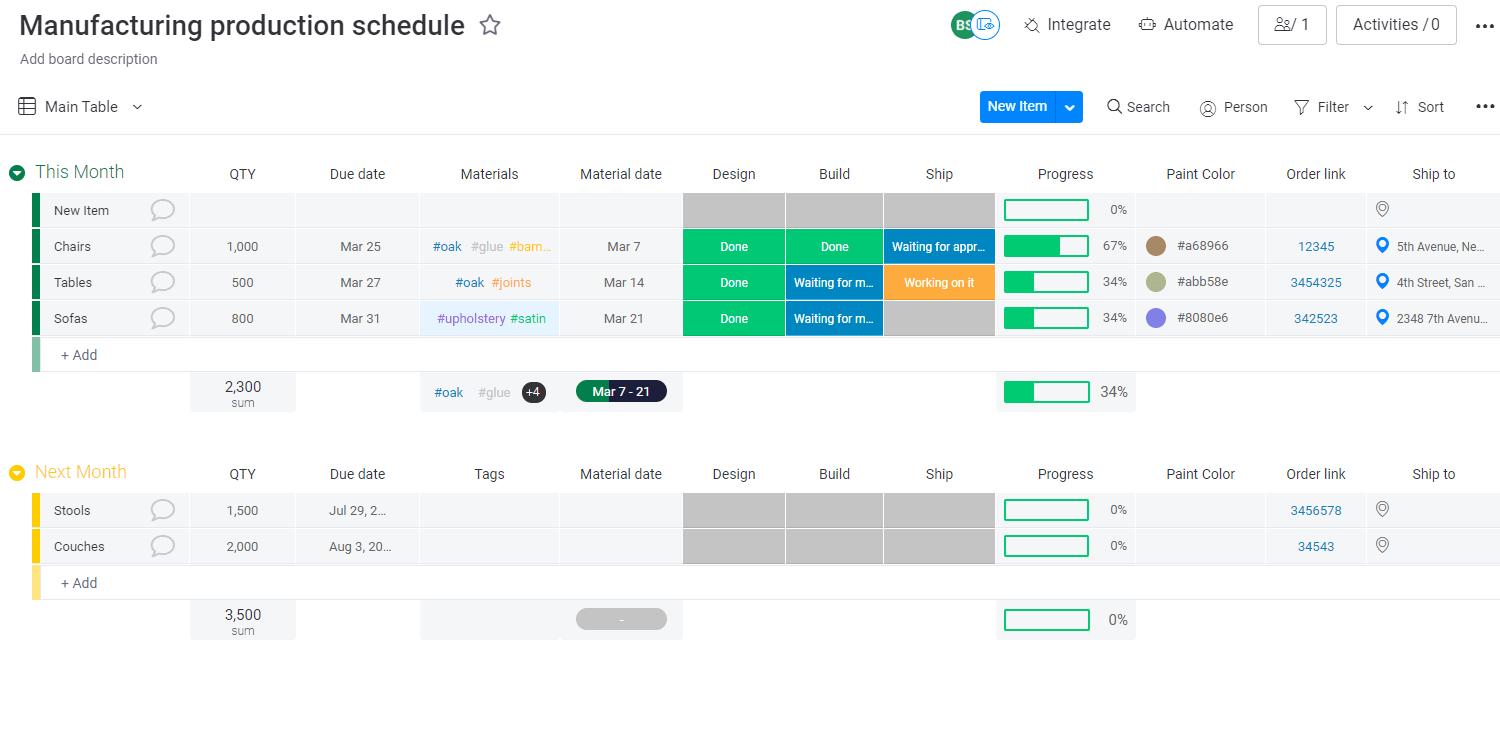
Production scheduling is a structured process that unfolds in 6 interconnected stages, each one building upon the last to create a seamless workflow from long-term strategy all the way to real-time optimization. By moving through these stages step by step, you ensure that every element — people, machines, materials, and information — works together to keep production running smoothly and efficiently.
Let’s break down what happens at each stage and how they fit together to form a system you can rely on:
Stage 1: Strategic planning
Strategic planning sets your big-picture production goals. You’ll analyze market demand, set production targets, and make sure your factory can handle what you’re planning. Look at long-term forecasts and consider seasonal changes, new product launches, and market growth that will affect what you need to produce.
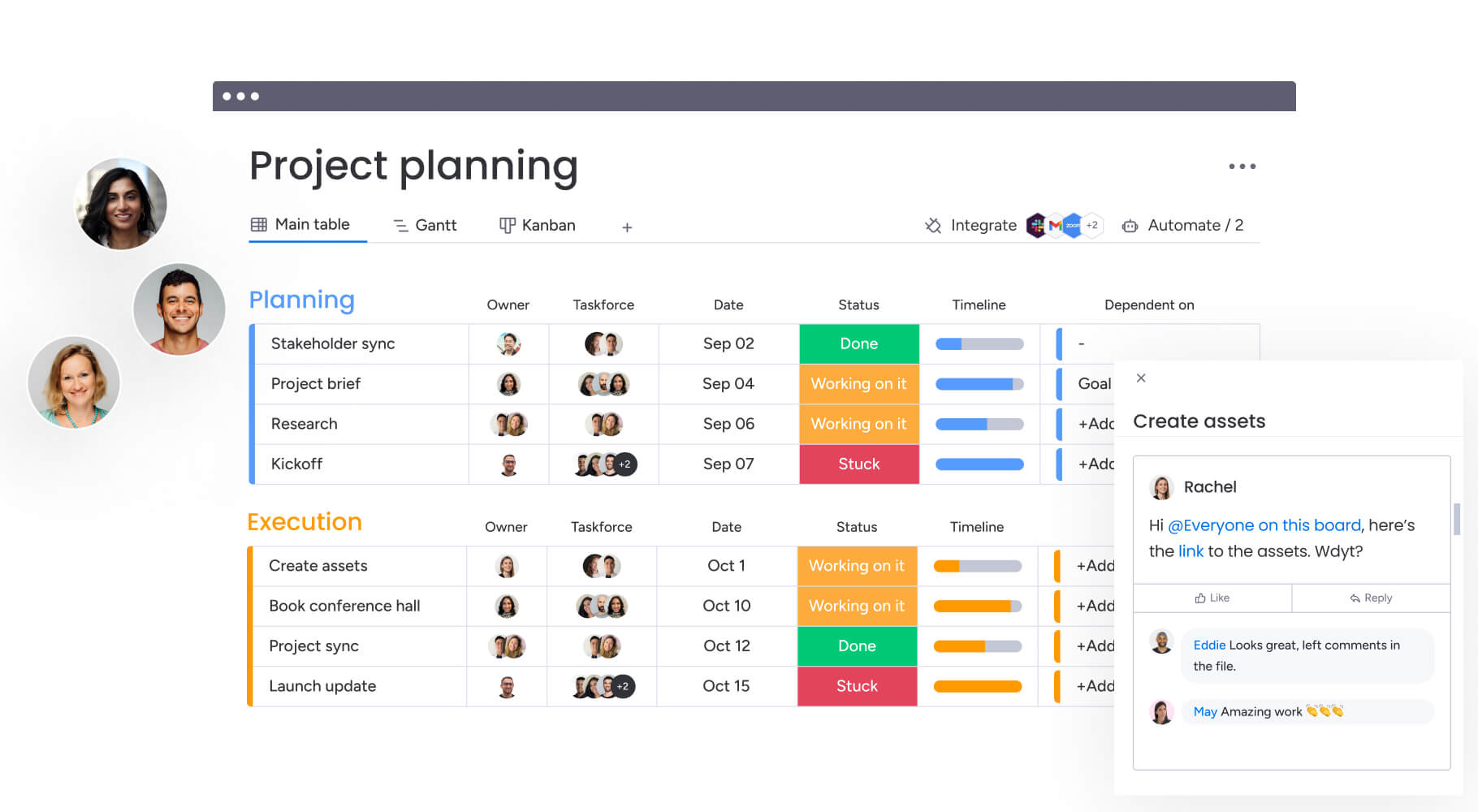
Stage 2: Routing and workflow mapping
Routing lays out the step-by-step journey each product takes across your factory floor, while workflow mapping details how materials and information flow between teams. By clearly documenting every stage — from the moment raw materials arrive to the instant finished goods leave your doors — you create a practical blueprint that keeps your scheduling on track and everyone aligned.
Stage 3: Schedule development
At this stage, it’s time to map out your real production schedule and decide when each activity begins and ends. Find that sweet spot between customer demand and your factory’s true capacity. Don’t forget to factor in setup times, cleaning between batches, and a little wiggle room for the unexpected. A balanced, realistic schedule keeps everything moving smoothly.
Stage 4: Work dispatching
Dispatching is all about giving your production teams clear, actionable work orders so everyone knows what to make, when to get started, and the quality standards to hit. This direct, transparent communication keeps confusion at bay and helps every team member understand not just their tasks, but the bigger picture and how their work directly impacts your ability to deliver on customer promises.
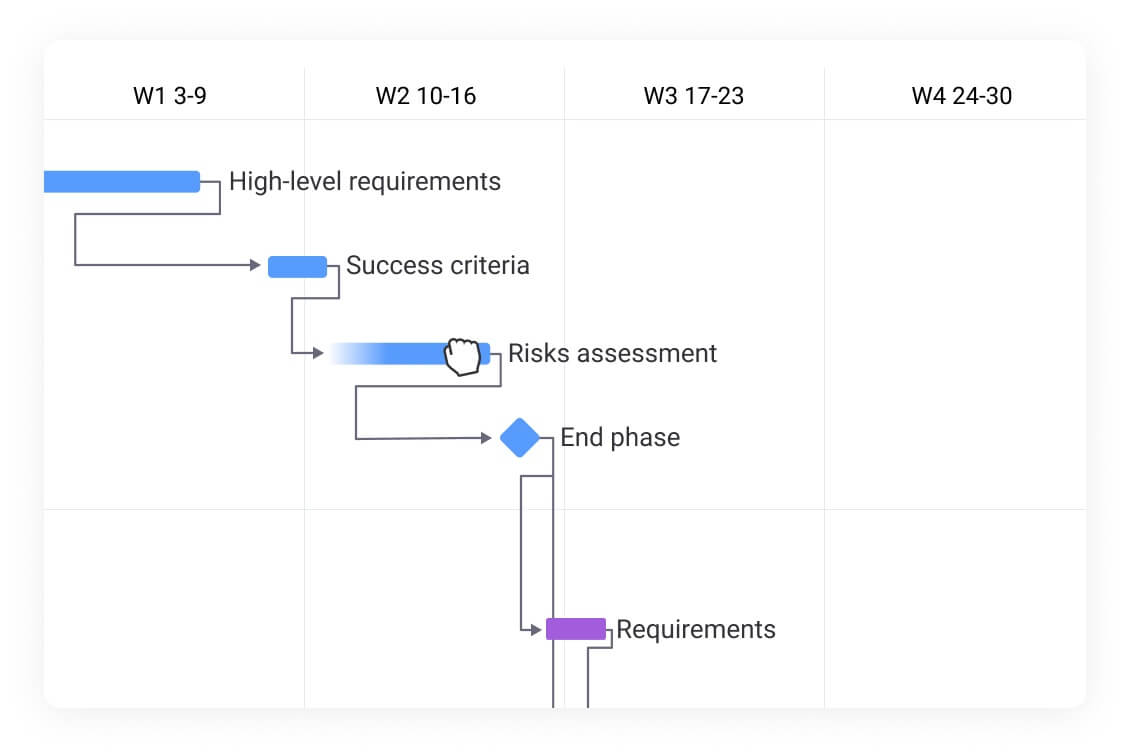
Pro tip: Use monday work management’s Gantt view to visualize the production timeline and see machine changeovers at a glance.
Stage 5: Production execution
This is where your plan hits the factory floor. Teams put the schedule into action, keeping a close eye on progress and staying nimble when surprises pop up. With real-time monitoring, you can catch issues early, whether it’s a machine hiccup or a late delivery. This allows you to pivot quickly to keep everything on track.
Stage 6: Continuous optimization
Once a production run wraps up, take a close look at what went smoothly and where things hit a snag. Use these real-world lessons to fine-tune your next schedule, making each cycle better than the last. Keep an eye on key metrics like on-time delivery and machine utilization to spot trends and celebrate wins as you go.
Try monday work managementHow to create a production schedule in 5 steps.
Creating a production schedule doesn’t have to be complicated. Follow these five steps to build schedules that actually work on your factory floor.
Step 1: Forecast demand and analyze orders
Start by gathering all customer orders and sales forecasts. Look at confirmed orders first, then add predicted demand based on historical patterns.
Consider special factors like promotional campaigns or seasonal peaks. A toy manufacturer might triple production before the holidays, while a sunscreen maker ramps up for summer.
Step 2: Evaluate production capacity
Figure out what your factory can actually produce. Check equipment availability, planned maintenance windows, and worker schedules.
Find your bottleneck — the one machine or process that limits everything else. If your packaging line can only handle 1,000 units per day, it doesn’t matter if assembly can make 2,000.
Step 3: Build your master schedule
Create a high-level schedule showing what gets produced each day or week. Start with your most important orders, then fill remaining capacity with standard products.
Leave some room for rush orders and unexpected changes. A flexible schedule with built-in buffer time can adapt to the first sign of a challenge.
Step 4: Assign resources and teams
Match specific workers and machines to each scheduled production order. Consider skill requirements — your most experienced operator should handle the most complex products.
Coordinate material deliveries to arrive just before you need them. This reduces inventory costs while ensuring production doesn’t stop.
Step 5: Establish tracking systems
Set up ways to monitor actual performance against your schedule. Track metrics like on-time completion rates and machine utilization.
Create simple dashboards that show schedule status at a glance. monday work management provides these automatically, so managers always know where things stand.
Production scheduling methods that drive results
Different factories need different scheduling approaches. The right method depends on your products, customers, and business goals. Here are a few you can choose from:
Forward scheduling
Forward scheduling starts production as soon as possible and pushes products through to completion. You begin when materials arrive and work forward to determine the finish date. This works well for standard products you make for inventory. It keeps machines busy and workers productive.
Backward scheduling
Backward scheduling starts with the customer’s delivery date and works backward to determine when to begin production. This ensures you meet deadlines without making products too early. Use this for custom orders with firm delivery dates. It prevents finished goods from sitting around waiting to ship.
Finite capacity scheduling
Finite capacity scheduling only schedules what your factory can actually produce. This method helps you build a schedule that aligns perfectly with your factory’s true production capabilities. This creates realistic schedules that production teams can actually achieve. The result is achievable deadlines that empower workers and satisfy customers.
Just-in-time manufacturing
Just-in-time (JIT) scheduling produces items only when customers order them. This minimizes inventory but requires excellent coordination with suppliers. JIT works best with reliable suppliers and predictable demand. This method’s success depends on exceptional coordination and highly reliable suppliers to keep the production line moving.
Hybrid scheduling approaches
Most factories combine methods for different situations. You might use backward scheduling for custom orders while using forward scheduling for standard products. With monday work management, you can handle multiple scheduling methods in one system. Set rules for different product types and let automation route work accordingly.
Try monday work management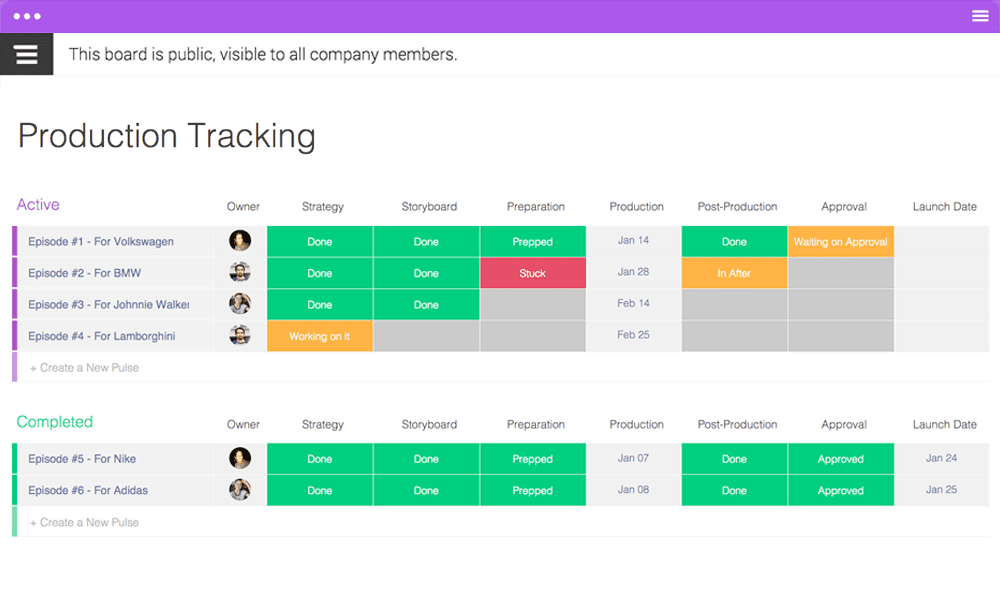
Key benefits of optimized production scheduling
Good production scheduling transforms manufacturing operations. Here’s what you gain when scheduling works well:
Maximized resource efficiency
Smart scheduling ensures machines and workers stay productive without burning out. In fact, manufacturers implementing smart factory initiatives report up to a 20% improvement in employee productivity and a 15% increase in unlocked capacity, according to a Deloitte survey, which helps maximize the uptime of expensive equipment.
- Balanced workloads: Spread work evenly across shifts and machines.
- Reduced downtime: Schedule maintenance during slow periods.
- Optimal batch sizes: Run the right quantities to minimize changeovers.
Greater cost-effectiveness
Every scheduling decision affects your bottom line. Good schedules reduce overtime, inventory costs, and rush shipping charges. Lower costs come from running equipment efficiently, ordering materials at the right time, and anticipating changes to act quickly and control expenses.
Improved delivery performance
Meeting delivery promises builds customer trust. Accurate schedules help you commit to realistic dates and then achieve them consistently, and reliable delivery becomes a competitive advantage. Customers choose suppliers they can count on, even if prices are slightly higher.
Enhanced operational transparency
When everyone can see the schedule, coordination improves dramatically. Potential challenges surface early, giving you ample time to address them. To get automatic visibility, monday work management offers dashboards that show real-time progress so managers can spot issues and help teams succeed.
Increased customer satisfaction
Happy customers come back and tell others about you. Production scheduling directly impacts satisfaction through on-time delivery and product availability. Predictable delivery lets customers plan their own operations better. They’ll value you as a partner, not just another supplier.
Strategies for overcoming common scheduling challenges
Every factory faces scheduling challenges. The key is having strategies ready to handle them. Here are the most common issues and practical solutions:
- If demand changes suddenly, build flexibility into schedules with buffer time and backup plans.
- If machines break down, schedule preventive maintenance and cross-train operators.
- If suppliers deliver late, work with multiple suppliers and maintain safety stock.
- If workers call in sick, cross-train team members and maintain a skilled temporary pool.
- If quality problems arise, build inspection points into the schedule to catch issues early.
5 strategies to optimize your production schedule
Once your basic schedule works, these strategies help you reach the next level of performance.
1. Leverage real-time data
Real-time data shows exactly what’s happening on your factory floor right now. You’ll see which machines are running, which orders are complete, and where problems are developing. Use this information to adjust schedules immediately when conditions change.
2. Automate routine scheduling workflows
Let computers handle repetitive calculations while you focus on strategic decisions. Automation updates schedules when orders change, calculates optimal sequences, and notifies teams about their assignments. Start with simple automations like sending alerts when schedules change, and build toward more complex automations as your team gets comfortable.
3. Build schedule flexibility
Flexible schedules bend without breaking when surprises happen. Create modular schedules that can be adjusted in sections rather than starting over completely. Keep some capacity uncommitted for rush orders, and maintain lists of tasks that can be moved if something urgent comes up.
4. Implement predictive analytics
Historical data reveals patterns that predict future problems. Spot when certain products tend to have quality issues or when specific machines typically fail, and use these insights to prevent problems before they happen. Schedule extra quality checks for problematic products and maintenance before machines usually break.
5. Foster cross-departmental collaboration
Great schedules require input from sales, purchasing, and production. Sales knows what customers need, purchasing knows when materials arrive, and production knows what’s actually possible.
Regular communication between departments ensures everyone is aligned and prepared for what’s next, especially since there is often a perception gap between leadership and employees. According to The world of work report from monday.com, although 92% of senior leaders believe their organization fosters shared ownership, only 76% of individual contributors agree. You can close this gap with greater communication, collaboration, and smart software that makes it all happen.
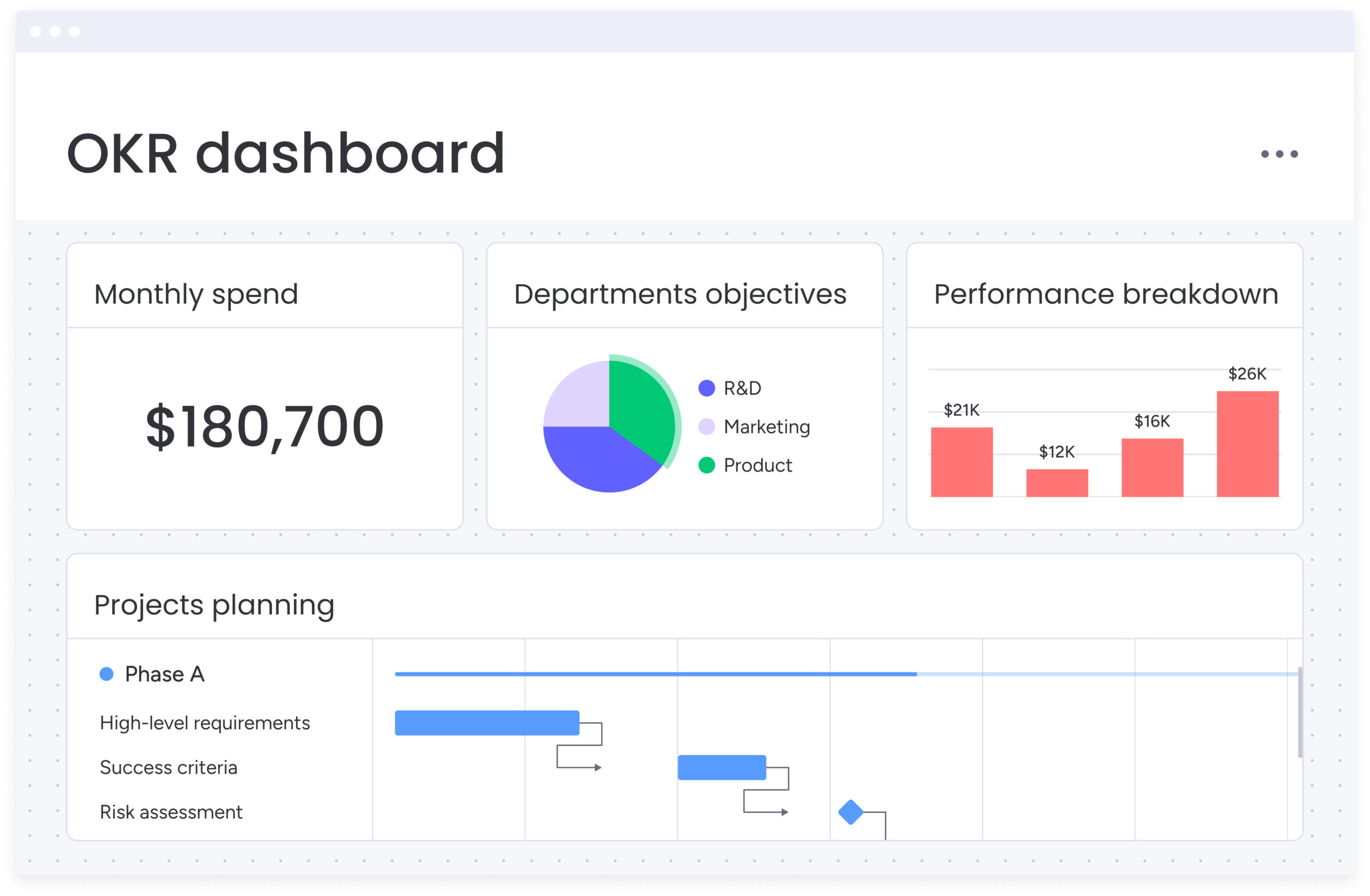
Production scheduling software for digital transformation
Top-performing factories need top-performing scheduling platforms, and with 82% of employees already use work management software, according to The world of work report, the move away from spreadsheets and whiteboards is a natural next step to handle today’s complexity and speed requirements.
In fact, a recent survey from Deloitte shows that advanced production scheduling is among the highest investment priorities for manufacturers over the next two years.
Digital scheduling platforms transform how you plan and execute production in the following ways:
- Instant updates: Changes appear immediately for everyone who needs to know
- Complex calculations: Optimize sequences considering multiple constraints simultaneously
- Integration: Connect with inventory, quality, and shipping systems automatically
- Scenario planning: Test different options before committing to a schedule
- Mobile access: Check schedules and make updates from anywhere
The right software and templates can make scheduling faster, more accurate, and less stressful for everyone involved.
Try monday work managementRevolutionize production scheduling with monday work management
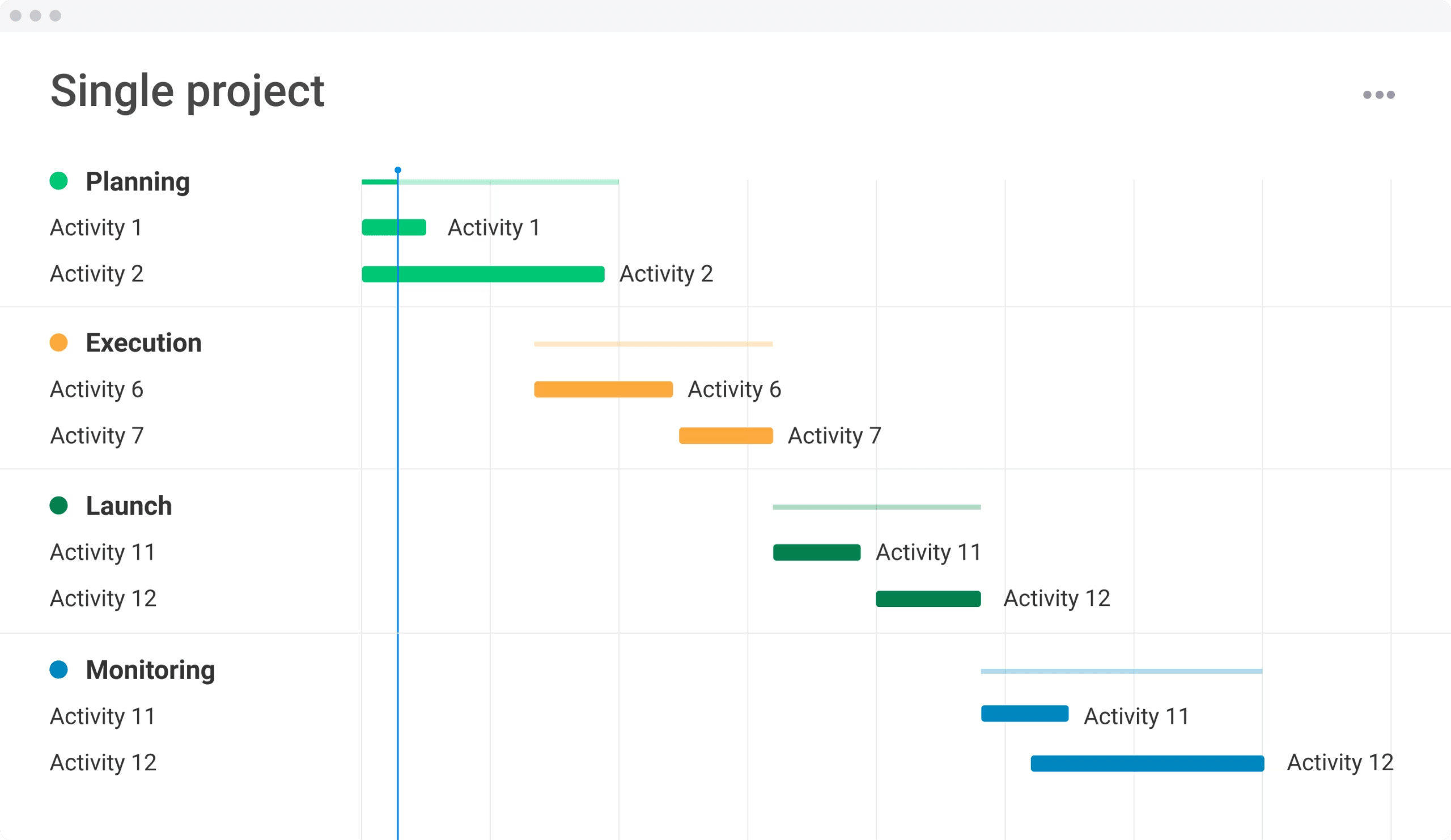
In manufacturing, every minute counts — and every schedule change has a ripple effect. To keep track of it all, monday work management gives you a single, visual command center for your production schedule.
Instead of juggling spreadsheets and paper charts, you get real-time visibility into every work order, machine allocation, and shift plan. Automation handles routine scheduling updates, such as adjusting downstream work when a machine goes offline, so your teams can focus on solving problems, not chasing paperwork.
Here are some key ways monday work management transforms production scheduling:
- AI-powered workload balancing: Automatically assign jobs to machines and operators based on skills, availability, and upcoming maintenance.
- Predictive insights for fewer delays: AI flags bottlenecks before they cause downtime, such as alerting you when a supplier delay will affect next week’s assembly line.
- Dynamic schedule updates: Drag-and-drop changes instantly update across the system, with notifications sent to the right teams and suppliers.
- Integrated operations view: Connect your ERP, inventory, and quality control tools so material requirements, machine status, and inspection checkpoints all sync with your schedule.
- Clear communication across departments: Sales sees when orders will ship, purchasing knows when materials are needed, and the shop floor sees their work orders in real time.
Real-world use case: A furniture manufacturer using backward scheduling sees a key sanding machine go down for maintenance. So, monday work management automatically reassigns jobs to available equipment, updates the Gantt chart, alerts the finishing team to expect a shift in delivery timing, and notifies purchasing to delay a related material shipment. The result? Zero wasted labor, no overtime, and an on-time customer delivery.
With monday work management, you’re not just building more than a schedule. You’re building the flexibility to hit deadlines, keep costs in check, and make smart, data-driven production decisions.
Get started with monday work managementFAQs
How often should production schedules be updated?
Production schedules should be updated whenever significant changes occur in demand, capacity, or resource availability. Most manufacturers review schedules daily and make major updates weekly, but high-volume operations might need hourly adjustments.
What scheduling method works best for small manufacturers?
Small manufacturers often succeed with backward scheduling combined with finite capacity planning. This approach ensures you meet customer deadlines while respecting the real limits of your equipment and workforce.
How do you handle rush orders without disrupting the production schedule?
Rush orders require quick evaluation of available capacity and current priorities. Check for gaps in the schedule first, then consider whether other orders can be delayed without impacting customer commitments.
Can production scheduling software work for custom manufacturing?
Production scheduling software excels at custom manufacturing by focusing on resource allocation and project phases rather than repetitive product runs. The key is choosing software flexible enough to handle unique requirements for each order.
What’s the difference between production scheduling and project scheduling?
Production scheduling manages ongoing, repetitive manufacturing processes with continuous cycles of similar work. Project scheduling handles one-time initiatives with unique deliverables and defined end dates.
How do you measure production schedule effectiveness?
Measure production schedule effectiveness through on-time delivery rates, resource utilization percentages, and schedule stability metrics. Track how often schedules change and whether those changes improve or hurt performance.
